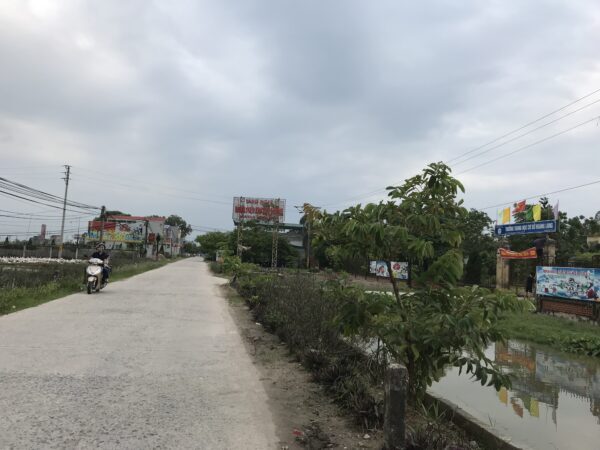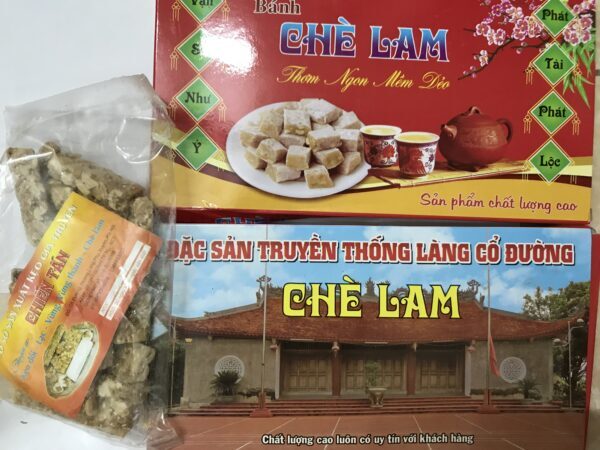In the past, confectionery of all kinds was not much, so this profession was very developed, experiencing ups and downs in history, sometimes the craft faded, and in recent decades, the traditional craft of the village has revived and developed. Currently, in the village, nearly 100 households are specializing in producing traditional confectionery, the average income per employee from VND 3-4 million / month.
Main confectionery products of the village include peanut candy, sesame candies, Che Lam – the simple and rustic gifts that are rich in traditional Vietnamese village flavors. In 2014, Co Hoang was the only confectionery village in Hanoi recognized by the city as a traditional craft village, according to Decision No. 7175/QD-UBND dated December 29, 2014, on the recognition of the title “Traditional Craft Village of Hanoi” of the People’s Committee of Hanoi City.
The village’s traditional confectionery profession is done for the whole year, but the busiest one is 3 months near the Lunar New Year Festival, when the visitors come to the village, they only feel the sweet aroma of sticky burns and roasted peanuts that the scent blends in the wind, mixed in clothes, making them question and remember forever.

Co Hoang Village
Co Hoang’s confectionery products are mainly handmade, a few stages have now been improved, bringing machines to support people such as kneading, packaging, fast and safe food hygiene. Thanks to handcrafting mainly and having its own secret, Co Hoang confectionery always has its own appeal and is favored by customers from near and far.
Co Hoang peanut candy is the most prominent and characteristic item of the locality. The candies are handcrafted and elaborate from the selection of ingredients, preliminary processing, cooking sugar, malt to packaging. The first is to choose peanuts, it must be a peanut variety with small seeds, even seeds, no black seeds, flat seeds are not as big as peanut sweets still sold in the market. After drying peanuts, they are put to roast directly on a cast iron pan with firewood, absolutely not drying in the oven like many other candy products. When the peanuts are just crunchy, they should be spread out, with a fragrant, nutty, crunchy flavor of traditional peanuts, and peanuts have a uniform yellow color. Peanuts are then mixed quickly and evenly with cooked malt, kneaded thoroughly, forming a mixture, the mixture is poured on a plate with rice flour underneath. Just quickly, you must be very strong to pour the mixture on a thin sheet and cover with sesame, then use a specialized knife to cut into bars and then cut long and short according to the size of the candy that the customer ordered. The most important step is to cook the malt so that it is both burn, just cooked, and has a golden color; If it is not done in right manner, it will be black, the color will be bitter, the color will not be yellow if it is done with no enough strength. The cooled malt is very hard, cutting will crumble, so it requires the worker to be quick, skillful and strong. According to a worker who has nearly 50 years of experience in work, for the quality of candy to be delicious and crispy, cooking and sugar are the most important. Required to keep the fire steady, not too big or too small; The sugar and the mixed in the pan are stirred evenly, quickly on the stove until the yellow color is clear.
Not only confectionery, Co Hoang people also make many kinds of cakes, such as pasta. Co Hoang Che Lam is made from ingredients such as yellow flower sticky rice, malt, ginger, peanuts, sesame and sugar cane. Ginger must choose old bulbs, peanuts must be old varieties, small but firm, plump, round seeds to ensure the aroma of the cake. Sticky rice with yellow flowers is round, plump and golden. Glutinous rice is roasted by hand into white burns, after being thoroughly sifted, the rice husks are removed and milled, then mixed and made into cakes.

Traditional confectionery products in Co Duong village (Co Hoang).
For decades, the traditional confectionery village of Co Hoang has participated in displaying and introducing products at the festival honoring traditional craft villages of Phu Xuyen district and many fairs and exhibitions of the city, attracting a lot of visitors to enjoy and buy as gifts.
In the village, there are about 30 production facilities, many large production facilities, products are not only sold throughout the country but also exported to many countries around the world, especially in Germany. On holidays, Tet holiday, large manufacturers may export 1-3 tons of cakes and candies per day. Chien Tan traditional candy production facility is one of the three most well-invested, methodical and highest-quality production facilities in the village. The owner is artisan Nguyen Thi Tan who is more than 60 years old. The artist’s family has had 5 generations of work. Many other establishments, though on a smaller scale, have had 3-4 generations of this traditional confectionery profession.
To catch up with the market mechanism and also to affirm the brand, most of the production facilities in Co Hoang village registered the trademark of Co Duong confectionery – the old name of the village. The village also established the Co Hoang traditional confectionery village club, which attracts more than 20 businessmen who own the production facilities in the village, in order to help each other develop production, expand markets, affirm the brand of traditional Co Duong confectionery.
Quynh Anh

